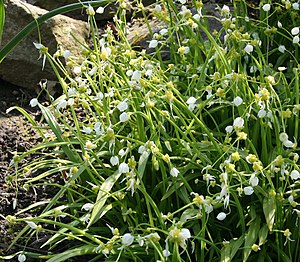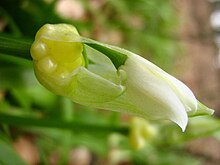Miracle leek
| Miracle leek | ||||||||||||
|---|---|---|---|---|---|---|---|---|---|---|---|---|

Wonder leek ( Allium paradoxum ) |
||||||||||||
| Systematics | ||||||||||||
|
||||||||||||
| Scientific name | ||||||||||||
| Allium paradoxum | ||||||||||||
| ( M.Bieb. ) G.Don |
Wonder leek ( Allium paradoxum ), also called strange leek or Berlin wild garlic , is a species of the leek ( Allium ) genus . Like wild garlic , it can occur in large numbers.
description
The strange leek is a perennial herbaceous plant that reaches heights of 20 to 30 centimeters. This geophyte forms bulbs with a diameter of up to 1 centimeter as a permanent organ; the paper-like tunic is gray-black. There is the typical smell of leek. The triangular stem is not leafed. Usually there is only one or sometimes three basal leaves. The sessile leaf is 20 centimeters long and 0.5 to 2.5 centimeters wide, curved, linear or elliptically lanceolate, keeled and narrowed at the base. The growing season lasts from early spring to the beginning of summer.
The flowering period is from April to May and lasts about 20 days. On a long inflorescence stem there is a golden inflorescence with usually two to five (zero to ten) nodding, long-stalked flowers and often up to twenty green bulbs, sometimes flowers are missing. There is a small bract. The hermaphrodite flowers are threefold, radial symmetry and broadly bell-shaped. The six identical bloom bracts are upright, blunt, durable and milky-white. The scar is three-lobed.
The number of chromosomes is 2n = 16.
Occurrence
The miracle leek is originally from the Caucasus , mountains in Central Asia and northern Iran . The miracle leek is an invasive species that is spreading en masse. In some European countries it is a neophyte .
Systematics
By Friedrich August Marschall von Bieberstein took place in 1819, the first publication of its kind under the name Scilla paradoxa in Flora Taurico-Caucasica , 3, 267. George Don put them in Memoirs of the Wernerian Natural History Society , 6, 1827, p 72 under the name Allium paradoxum into the genus Allium . Allium paradoxum belongs to the Briseis section in the Amerallium subgenus within the Allium genus .
Others
The miracle leek forms grass-like stocks from March that bloom before the wild garlic and wither again in June. Like wild garlic, the strange leek has a typical smell like chives , onions or garlic and is edible like these.
swell
- Allium paradoxum at Ornamental Plants From Russia And Adjacent States Of The Former Soviet Union . (Section description)
- Allium paradoxum (M. Bieb.) G. Don, Wunder-Luch. In: FloraWeb.de.
Individual evidence
- ^ Erich Oberdorfer : Plant-sociological excursion flora for Germany and neighboring areas . 8th edition. Page 128. Stuttgart, Verlag Eugen Ulmer, 2001. ISBN 3-8001-3131-5
- ↑ Rafaël Govaerts (Ed.): Allium paradoxum - data sheet at World Checklist of Selected Plant Families of the Board of Trustees of the Royal Botanic Gardens, Kew. Last accessed on September 22, 2016.
- ↑ Allium paradoxum at Tropicos.org. Missouri Botanical Garden, St. Louis, accessed September 19, 2015.
- ^ Allium paradoxum in the Germplasm Resources Information Network (GRIN), USDA , ARS , National Genetic Resources Program. National Germplasm Resources Laboratory, Beltsville, Maryland.
- ↑ Evolution of life strategies and population biology of the invasive species Allium paradoxum ( Memento of the original from April 29, 2016 in the Internet Archive ) Info: The archive link was inserted automatically and has not yet been checked. Please check the original and archive link according to the instructions and then remove this notice. (Research project)
Web links
- Miracle leek . In: BiolFlor, the database of biological-ecological characteristics of the flora of Germany.
- Thomas Meyer: Data sheet with identification key and photos at Flora-de: Flora von Deutschland (old name of the website: Flowers in Swabia )
- Allium paradoxum at Plants For A Future
- Allium paradoxum (M. Bieb.) G. Don, map for distribution in Switzerland In: Info Flora , the national data and information center of the Swiss flora .
- Allium paradoxum (M. Bieb.) G. Don In: Info Flora , the national data and information center of the Swiss flora .

